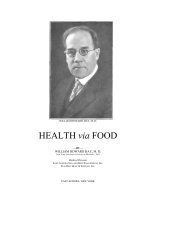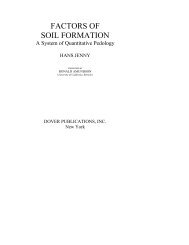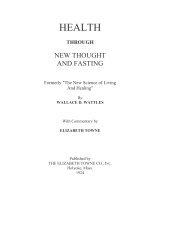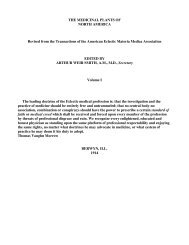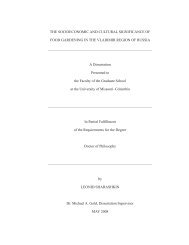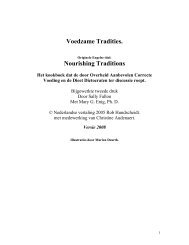historical and scientific perspectives on the health of canada's first ...
historical and scientific perspectives on the health of canada's first ...
historical and scientific perspectives on the health of canada's first ...
You also want an ePaper? Increase the reach of your titles
YUMPU automatically turns print PDFs into web optimized ePapers that Google loves.
Yuk<strong>on</strong> Territory & Alaska Aboriginals – Nutriti<strong>on</strong> & Physical Degenerati<strong>on</strong>, Photos pp. 79, 81, & 67 Respectively<br />
All <strong>the</strong> foods <strong>of</strong> <strong>the</strong>se nature based societies grew in unpolluted envir<strong>on</strong>ments free <strong>of</strong> artificial<br />
chemical fertilizati<strong>on</strong>, <str<strong>on</strong>g>and</str<strong>on</strong>g> neuro-toxic pesticides. These peoples ate no canned or processed<br />
foods <str<strong>on</strong>g>and</str<strong>on</strong>g> used no alcohol, c<strong>of</strong>fee, tea, pastries, c<str<strong>on</strong>g>and</str<strong>on</strong>g>ies, sugared drinks, or colas. Whole races<br />
have been damaged <str<strong>on</strong>g>and</str<strong>on</strong>g> in some cases wiped out after introducti<strong>on</strong> <strong>of</strong> <strong>the</strong> highly devitalized diet<br />
called "civilized." Am<strong>on</strong>g <strong>the</strong> native Hawaiians who maintained <strong>the</strong>ir traditi<strong>on</strong>al diet, dental<br />
caries were <strong>on</strong>ly 0.02 %. In c<strong>on</strong>trast, when <strong>the</strong>y adopted <strong>the</strong> foods <strong>of</strong> modern commerce, decay<br />
levels increased up to 80%. “Many were suffering from degenerative diseases. The effects <strong>of</strong><br />
Western civilizati<strong>on</strong>'s diet <strong>of</strong> death <strong>on</strong> o<strong>the</strong>r races is more rapid <str<strong>on</strong>g>and</str<strong>on</strong>g><br />
<strong>the</strong>refore more apparent than what we are doing to ourselves. But<br />
<strong>the</strong> white man is eating his way out <strong>of</strong> existence. He is committing<br />
slow suicide <strong>on</strong> a racial scale.” 112<br />
A study covering <strong>the</strong> period <strong>of</strong> 1968-7 found that New Zeal<str<strong>on</strong>g>and</str<strong>on</strong>g><br />
Maoris compared to <strong>the</strong>ir Polynesian counterparts who live in <strong>the</strong><br />
remote isl<str<strong>on</strong>g>and</str<strong>on</strong>g>s <strong>of</strong> <strong>the</strong> Pacific, appeared more inclined to suffer<br />
infecti<strong>on</strong>s, rheumatic fever, <str<strong>on</strong>g>and</str<strong>on</strong>g> tuberculosis. They also seemed<br />
c<strong>on</strong>siderably more pr<strong>on</strong>e to develop hypertensi<strong>on</strong>, heart disease, <str<strong>on</strong>g>and</str<strong>on</strong>g><br />
diabetes, afflicti<strong>on</strong>s which are virtually foreign to more traditi<strong>on</strong>al<br />
living isl<str<strong>on</strong>g>and</str<strong>on</strong>g>ers. Despite material improvements, as measured by<br />
European st<str<strong>on</strong>g>and</str<strong>on</strong>g>ards, Maori women between 35 <str<strong>on</strong>g>and</str<strong>on</strong>g> 55 years in age<br />
in New Zeal<str<strong>on</strong>g>and</str<strong>on</strong>g>, suffered from hypertensi<strong>on</strong> <str<strong>on</strong>g>and</str<strong>on</strong>g> cor<strong>on</strong>ary heart<br />
disease four to five times as frequently as did <strong>the</strong>ir female ethnic<br />
cousins <strong>of</strong> <strong>the</strong> same age group who maintained <strong>the</strong>ir traditi<strong>on</strong>al<br />
lifestyles <strong>on</strong> <strong>the</strong> atolls <strong>of</strong> <strong>the</strong> Central Pacific. 113<br />
2.4.1 Key Nutrient Intake <strong>of</strong> Canada’s First Peoples<br />
Using field data from Price’s research in highly remote regi<strong>on</strong>s <strong>of</strong><br />
Northwestern Canada <str<strong>on</strong>g>and</str<strong>on</strong>g> Alaska <strong>the</strong> FIGURES II, III <str<strong>on</strong>g>and</str<strong>on</strong>g> IV 114 <strong>on</strong><br />
<strong>the</strong> next page compare some key nutrient intakes <strong>of</strong> Canada’s <strong>first</strong> Pacific Isl<str<strong>on</strong>g>and</str<strong>on</strong>g> Polynesians<br />
peoples when still living <strong>on</strong> <strong>the</strong>ir traditi<strong>on</strong>al foods, in c<strong>on</strong>trast to <strong>the</strong> Recommended Dietary<br />
Allowance (RDA). 115 The high nutrient levels <strong>of</strong> <strong>the</strong>se peoples ensured that <strong>the</strong>y enjoyed<br />
outst<str<strong>on</strong>g>and</str<strong>on</strong>g>ing levels <strong>of</strong> natural immunity to tooth decay <str<strong>on</strong>g>and</str<strong>on</strong>g> a general freedom from degenerative<br />
disease processes. Similar high mineral <str<strong>on</strong>g>and</str<strong>on</strong>g> vitamin intake levels were also exhibited by remote<br />
Polynesians, Melanesians, pastoral <str<strong>on</strong>g>and</str<strong>on</strong>g> agriculturist Africans, <str<strong>on</strong>g>and</str<strong>on</strong>g> South American Indians who<br />
38



